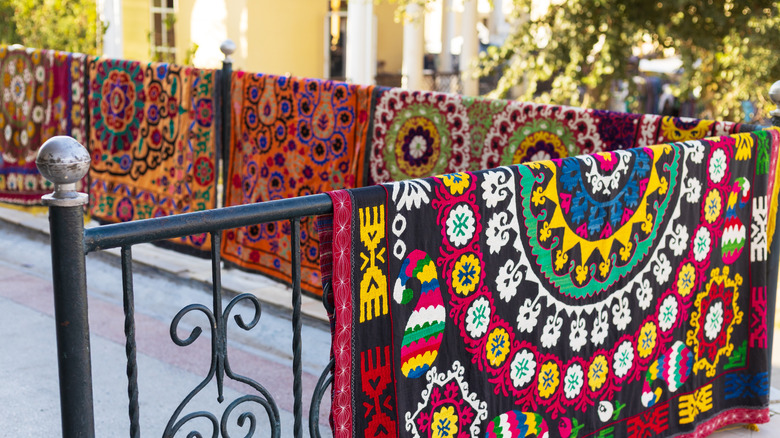The Valuable Vintage Item You Can Thrift That Collectors Want To Get Their Hands On
There's a saying: Everything old is new again. Trends always come back around. Whether it's geometric patterns from the 1960s, disco style from the '70s, or even art deco designs from the '20s, they've all come back around at some point, new and shiny. However, this also applies to older trends and styles, even dating back to the late 18th century of Kazakhstan, Tajikistan, and Uzbekistan. Vintage embroidered suzani textiles are a treasured antique item that's dominating 2025 thrifting trends, and there's more than one reason why collectors want to get their hands on them.
Suzani textiles are embroidered panels made of either cotton or silk. They're a cross between rugs and throws, typically layered on floors or hung on the walls for an artistic touch. Since they're completely handmade and hand-embroidered with natural vegetal dyes, their quality and vibrant colors are unmatched. Deriving from the Persian word "suzan," which means "needle," these beautiful pieces of needlework were originally part of a bride's dowry as a way to bring protection and strength to the marriage. They often contain motifs, such as the sun and moon, flowers, pomegranates, fish, and birds, that were said to be symbols of luck, health, long life, and fertility. This rich history combined with the exceptional quality of work makes these vintage pieces valuable to collectors and interior designers alike.
How to incorporate the honor of a suzani in your home
If you're lucky enough to find a suzani textile at your local thrift store, one way to check its authenticity is through the hues and stitching. If it's truly a vintage suzani, the colors and hues should be more vibrant because of the natural dyes. While synthetic dyes can also create pretty colors, they aren't quite as bright or deep as vegetal ones. The stitching is also different on a real suzani because they're handmade. Traditional hand-embroidery is not uniform and often has irregular stitches and knots on the back, which is much different compared to machine embroidery.
As for incorporating embroidery art in your home, there are a few ways you can display a suzani. Back in the late 18th and early 19th centuries, the nomadic tribes of Central Asia used suzanis as prayer mats, bed sheets, and seating areas in yurts instead of furniture because furniture was too difficult to move. While you can still use a vintage suzani as a rug, the aged fibers and threads can sometimes be fragile. Sometimes, it's better to hang them on the walls as artwork to keep them safe and clean while displaying the gorgeous handiwork and vibrant colors.

